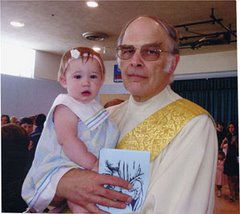Luke 24:35 - 48
Some of you may be familiar with the
Go Local magazine that you can pick up free in your grocery store.
The last issue featured an article on a man named Timothy Payne. He
was a soldier in Afghanistan, and one day he stepped on a concealed
explosive device. He lost both legs and severely damaged one arm.
He could not be fitted for prostheses because their was nothing to
attach a prosthesis to. After a very long period of rehabilitation,
a bout of drug addiction, suicidal thoughts and PTSD, he finally came
out of his ordeal. He now goes around working to connect disabled
veterans with their community resources and speaking to various
groups about their problems. In his spare time he participates in
various sports – scuba diving, long distance swimming, racing on
his arm-powered tricycle – and he has put more than 100,000 miles
on the van he has fitted out so he can drive it. And when people
first meet him, he tells them, “I got blown up” and smiles. His
body shows the marks of his experience; it can't be hidden.
When you think about this gospel we
just heard, it sounds very familiar. Jesus appears, the disciples
can't believe it, they recognize him, then the are joyful. But if
you were trying to convince someone that you were not dead, would you
show them your hands and feet? We know from the story of Thomas that
Jesus risen body showed the nail marks in his hands and the spear
wound in his side. Jesus did not conquer death and come back as
though his battle never happened. He wore the signs of his death on
his living body. He did not avoid death, he went through death;
death could not stop him, but put up a pretty good fight. And that
may be why the apostles were incredulous. Besides the hands and
feet, they very well may have seen the marks on his head from the
crown of thorns; they may have seen streaks of dried blood on his
face. It's as though Jesus is saying, “I'm just like you, I'm
alive to pain and suffering. I'm not immune. This body is real. The
theologian James Allison said, “Jesus wore death on his body like a
trophy, and he can show his death to others to allay their fears.”
We Catholics unlike most other Christians, decorate our churches and
homes and sometimes even our bodies with realistic images of Christ
on the cross. At some level we see these as symbols of death
conquered.
The other odd thing about this gospel
story is that Jesus asks for something to eat and then eats it. Now
if you read the gospels you might say, “You can usually find Jesus
around food – the wedding feast at Cana, the meal with Mary and
Martha and Lazarus, the meal Peter's mother in law prepared after he
healed her, eating with Simon the leper, with the Pharisee, with
Zaccheus – and when Jesus isn't popping up at banquets he makes
them himself – the feeding of the crowds comes to mind. And of
course, Jesus instituted the central sacrament of Christianity, the
Eucharist, at a real meal, a Passover meal. If you read the gospels,
you know he had a healthy appetite. So it isn't surprising that
after battling death and conquering death, he does something his
disciples recognize – he asks for something to eat. As you can
tell, I think this is one of those places in the scriptures where we
are allowed a little smile.
But more seriously, we can look at
this event as Jesus putting on a show, or Jesus really desiring to
eat something, Jesus physically hungry. If he is putting on a show
then he is not authentic; but if he is truly hungry, then he not only
has returned in his body, but in a way he has made holy those
impulses of the body. If Jesus rose from the dead so that we could
rise at the end of our lives, Jesus was hungry and thirsty and in
need of human companionship after the Resurrection because that is
human, truly human. Jesus in not merely carrying out a demonstration
for us, that he is risen; He is by his actions blessing and making
holy everything we do, little pleasures, great pains, fellowship with
each other – as Jesus lives through his post-resurrection days, he
shows us that our bodies are loved, are blessed, are immortal.
Why is this emphasis on the body so
important? Because our bodies are the means by which we love and are
loved. And when Jesus rises from the dead in the flesh, he makes
human flesh sacred. And the consequences of that are incredible. If
Jesus' body is sacred, so is mine, so is yours, so is the body of the
woman pushing a shopping cart with all her belongings in it, so is
the body of the man sentenced to life in prison; so is the body of
the person with end stage Alzheimer's disease – human bodies are
sacred because Jesus still even today lives in a human body. He
didn't just cast it off and ascend into heaven 40 days after he rose
from the dead. He continues for all eternity to share our humanity
because he took on our flesh and will never leave it.
Thomas Merton had a revelation while
standing on a street corner in Louisville. He wrote:
“I was suddenly overwhelmed with the
realization that I loved all of those people, that they were mine,
and I, theirs, that we could not be alien to one another even though
we were total strangers. It was like waking from a dream of
separateness … Then it was as if I suddenly saw the secret beauty
of their hearts, the depths of their hearts, where neither sin, nor
desire, nor self-knowledge, can reach the core of their reality, the
person that each one is in God’s eyes. If only we could all see
each other that way all the time! There would be no more war, no more
hatred, no more cruelty, no more greed. I suppose that the big
problem would be that we would all fall down and worship each other.”
The Resurrection of Jesus, the fact
that God became man and conquered death for you and I, really does
unite us all to each other and to Him. Let us be Resurrection
people.



































